Archive for December, 2013
Trail carving on the south side of the RMZ
TRAILS: 2.5 hours: 12:15 PM to 2:45PM
Finish-grading of East Hill trail heading up through RMZ unit #3.
Carved and finish-graded the bottom 110 feet of the East Hill trail on the upper south side of the creek in RMZ unit #3, from the creek crossing up towards the Great Cedar Snag. Cut a fairly straight, moderate angle up the steep slope, eliminating the embedded wood chunks, humps and depressions along the way. Left two large wood chunks in the path that will have to be chain-sawed out. Large old logs lying parallel on the downhill side of the path provide much needed support. Without the logs as backstops, the downhill side of the trail has a tendency to slough off. The trail bed needs to be primarily carved INTO the hillside, rather than relying on the fill dumped to the OUTSIDE, which inevitably settles lower over time.
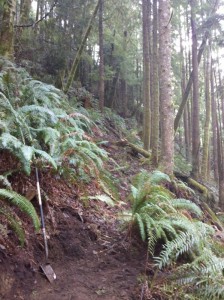
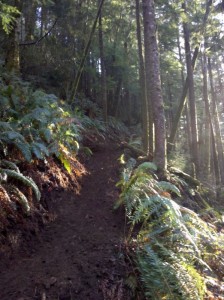 Before and After: East Hill trail.
Before and After: East Hill trail.
The roughed-out route on the left is too lumpy with a lot of ankle-twisting side slope. The finished grade on the right has a consistent rise with a level cross-slope for stable footing. Many of the overhanging sword ferns were removed, as they tend to grow into and obscure the trail. This is a steep hill that we climb at a gradual angle to minimize erosion. This photo looks SW up the slope from the upper creek basin.
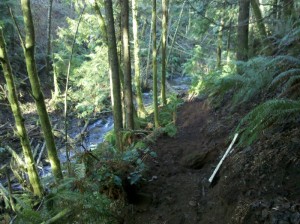 Finished East Hill trail looking back down to the creek.
Finished East Hill trail looking back down to the creek.
Notice the big old log on the left (downhill side of the trail). It is firmly embedded into the hillside, and it provides a valuable support for the trail, allowing it to be widened here. We really need to carve into the bank to get a firm trail base, but fortunately the soil is soft and can be easily worked with simple tools like a pointed shovel. A few big wood chunks remain in the trail (behind the yellow axe), which will require a chainsaw to remove.
Continue Reading | Comments Off on Trail carving on the south side of the RMZ
Trail Carving on East Ridge
TRAILS: 2.25 hours: 10:00 AM to 12:15 PM
Finish-grading of East Ridge trail in North Side unit #5.
Carved and finish-graded 60 feet of the lower section of Eastern Ridge trail in North Side unit #2. Dug out stumps and rocks, shoveled dirt from high spots to low spots to create a smooth grade one to three feet wide. Maintained a fairly straight trajectory, occasionally diverting around or highlighting interesting features like bleached corkscrew roots and nurse logs. This trail showcases a lot of the wood “architecture” of this forest, both dead and alive.
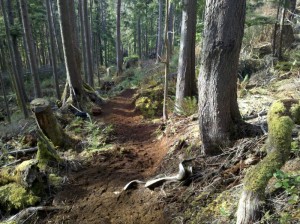 The end result of carving and finish-grading East Ridge trail.
The end result of carving and finish-grading East Ridge trail.
It can be challenging to find an attractive, natural-looking route for a trail, especially in steep and lumpy terrain. This section of the East Ridge trail had some nice wooden architecture on both sides to frame and direct the trail down the slope. I dug out most of the stumps and rocks to create a smooth grade, but sometimes a unique feature like this exposed corkscrew root is worth incorporating into the trail to pause the flow like a log in a stream.
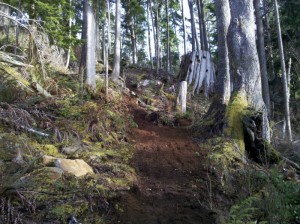 Finish-graded East Ridge trail, looking uphill.
Finish-graded East Ridge trail, looking uphill.
I stopped the carving at a point where the trail heads sharply uphill to the left (in the middle of the picture). I may re-route the trail on a more gentle grade, perhaps via a switchback up next to the ancient cedar stump on the right. I don’t want to expend the effort and hack up the landscape until I have evaluated all the route options. The section I cleared was a “natural” route, pioneered by elk, so it made sense to turn it into a formal trail.
Continue Reading | Comments Off on Trail Carving on East Ridge
Forestry in the Collapsed Hemlock Thicket
FORESTRY: 2.5 hours: 3:00 PM to 5:30 PM
Slashing of brush and broken trees, plus thinning and pruning in the south side of Eastern Wedge unit #5.
Forestry portion of trail project in the south end of Eastern Wedge unit #5. Slashed down immense thickets of tall, decrepit salmonberry/elderberry brush, along with bent and broken hemlock clumps. Cut down the leaning alders and pruned the good ones. Turned an impenetrable zone into an accessible, attractive stand with good specimens and some room for new trees to grow in the small openings. Covered much of the area above the trail up towards the eastern property line.
Continue Reading | Comments Off on Forestry in the Collapsed Hemlock Thicket
Finished East Hill Trail
TRAILS: 4 hours: 11:00 AM to 3:00 PM
Finished the trail from the South Seep to the High Road in Eastern Wedge unit #5.
New trail creation. Finished the main trail through Eastern Wedge unit #5, connecting the north and south ends through the collapsed hemlock thicket on the south side of the seeps. Routed the trail a little higher than the path I roughed out the other day, to avoid a dip into a stream ravine. Ended up on higher, drier ground with a mellow stream crossing. Also placed a few cedar shake bolts as stepping stones across a wet area. Cleaned up the southern approach that had been roughed out weeks earlier, including slicing up and rolling away large, rotten log chunks.
Continue Reading | Comments Off on Finished East Hill Trail
Trail creation from South Seep to High Road
TRAILS: 1.5 hours: 4:00 PM to 5:30 PM
Roughed out a trail route to connect the South Seep to the trail from High Road in Eastern Wedge unit #5.
New trail creation – continued main trail through Eastern Wedge unit #5. Cut through the collapsed hemlock thicket on the south side of the South Seep, roughing out the final connection to the previously cleared trail coming from the south. Trying to keep the trail on the high side to avoid the dips into the stream ravines. Lots of low branch pruning on trees along the trail route.
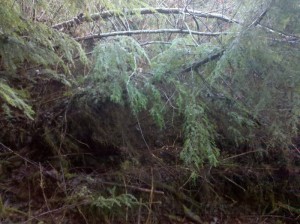 Collapsed hemlock thicket along the trail route south of South Seep.
Collapsed hemlock thicket along the trail route south of South Seep.
Evidence of an ice storm or snow loading event is everywhere in this unit: entire collapsed stands, individual leaners, broken tree tops and hanging branches. Will have to cut through the middle of this to create the trail. Plenty of cleanup in the rest of the unit once the trail is established.
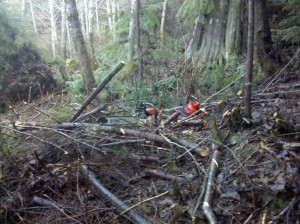 Slashed trees and brush at the edge of the collapsed hemlock thicket.
Slashed trees and brush at the edge of the collapsed hemlock thicket.
End result of cutting through the downed trees: “carpet-bombing” the forest floor. The trail will run along the right side of the photo, at the foot of the old cedar stump. Looking back north through the area just completed, the individuated trees are clearly visible. It is much easier to walk around in this unit now.
Continue Reading | Comments Off on Trail creation from South Seep to High Road
Trail revision through the Alder Seep
TRAILS: 2.75 hours: 1:15 PM to 4:00PM
Opened up a higher, more level route into the Alder Seep in Eastern Wedge unit #5.
Trail revision in Eastern Wedge unit #5. Cut a new route on the north side of Alder Seep to maintain the level grade as much as possible and avoid the original dip in the trail. Cut through the Doug firs on the hillside and emerged higher in the seep, with a gentle climb through the seep to the section on the south side. Test-carved the soft soil with the hand saw to create a level grade for walking – will return with a shovel and axe to finish the job. Only had to cut down one Doug fir (they are closely spaced here – this is one small part of the plantation that survived at close to its original stocking level).
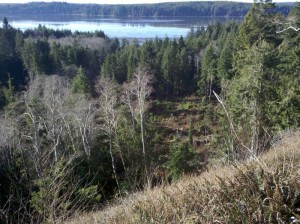 View to the SW over the mouth of Clearwater Creek Creek into Chetlo Harbor.
View to the SW over the mouth of Clearwater Creek Creek into Chetlo Harbor.
The body of water in the background is the tidal Naselle River (coming in from the east – on the left), emptying into Chetlo Harbor, a SE arm of Willapa Bay. Only a few residents and one oyster processing facility around this cove. Willapa Bay is the most pristine estuary on the west coast of the U.S.
Continue Reading | Comments Off on Trail revision through the Alder Seep
Trail revision across Clearwater Creek
TRAILS: 1.25 hours: 12:00 PM to 1:15 PM
Opened up a new upper creek crossing between the North Side and South Side trails in RMZ unit #3.
Trail revision across the creek. Opened up a new route across the creek at the upper end where the north and south side trails meet. The previous route was across “stepping stones”, but only works during low flows. About 25 feet upstream is a collection of old, large, mossy logs that bridge the creek, so I cleared paths to and across them. Extended the trail on the north side past the seep up to the log jam through dry terrain. Still need to carve the trail for better footing and deal with the wet section at the seep.
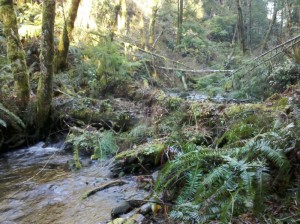 Newly opened creek crossing over big, mossy logjam.
Newly opened creek crossing over big, mossy logjam.
About 25 feet up from the stepping stone crossing, this logjam will work for high water events. It has obviously been in place for a long time, with the creek managing to flow under and around it during many years of heavy rains.
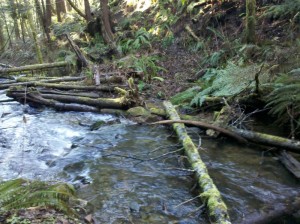 Original creek crossing over stepping stones.
Original creek crossing over stepping stones.
Even with an extended winter drought, the stepping stones are partially underwater and this crossing can only be used during extremely low-water conditions (unless you have rubber boots!).
Continue Reading | Comments Off on Trail revision across Clearwater Creek
Forestry work in the South Seep
FORESTRY: 4 hours: 1:30 PM to 5:30 PM
PC Thinning, brush slashing and broken tree removal in the South Seep in Eastern Wedge unit #5.
Forestry work in the South Seep area of Eastern wedge unit #5. A lot of alder branch pruning, up to the eastern property line and down into the lower part of the seep. Also slashed down ubiquitous old salmonberry and some red elderberry as part of the clean-up process. I do not expect the salmonberry to regenerate successfully in this closed canopy young stand. Heading south of South Seep, there is an immense amount of horizontal hemlock – whole clumps keeled over from what appears to have been an ice or snow loading event. Numerous broken tops on the Doug firs indicate this as well. Remarkable that the alder is mostly damage-free: beautiful, tall, well-spaced specimens. I noticed that some of the alders have broken lower branches – cracked and dangling, indicating snow/ice load damage rather than wind-based damage. Started slashing down the horizontal hemlock clumps (stems only a few inches in diameter) until I ran out of light. Constant drizzle soaked me thoroughly by the end of the day.
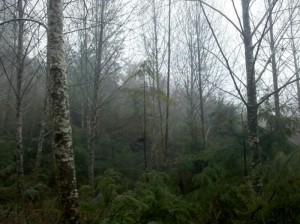 Suppressed Doug Fir in the Alder-dominated South Seep.
Suppressed Doug Fir in the Alder-dominated South Seep.
The lone, emaciated Doug Fir in the center of the photo (with a bird nest to the left of the trunk) was planted right after the clear-cut approx. sixteen years ago. This stand should be full of robust Doug fir, but the naturally re-seeded alder shot up faster and shaded out nearly all of the Doug fir in this grove. Proper management of Doug fir requires control of competing hardwoods and brush. Because there was no follow-up treatment in this stand, the fir has mostly died. Fortunately, the alder came in strong with good natural spacing, so it is a commercially viable alternative.
Note the extensive, shrubby hemlock in the understory. These trees look pretty pathetic, but they are biding their time, waiting for a weather event or humans to take out the alder. When they get an opening in the canopy, they will shoot up to claim it. Hemlock’s lifespan is roughly ten times that of the alder, so they will be here for the long haul.
Continue Reading | Comments Off on Forestry work in the South Seep
Trail creation through the South Seep
TRAILS: 2 hours: 11:30 AM to 1:30 PM
Trail creation through the South Seep in Eastern Wedge unit #5.
Trail creation through the South Seep in Eastern Wedge unit #5. Started where I left off a few days ago, heading from north to south from the raised section between Alder Seep and South Seep. There is less water running through this section, but still need to work out how to cross the wet spots to avoid pugging them out. Cleared all the way through South Seep, then hacked through the brush and horizontal trees to meet up with the trail coming from the south side – only a hundred feet or so south of the seep. If I keep following the contour, I will run right into it – no need to dip down or rise up. Although this last stretch of un-cleared trail is short, it is the most dense and impenetrable thicket yet – a solid, extended plug of branchy biomass. The eastern boundary line is within 100 feet of this section of trail. I may re-route the trail section just north of Alder Seep to avoid the difficult dip into and rise out of the seep – trying to keep it “on the level” as much as possible.
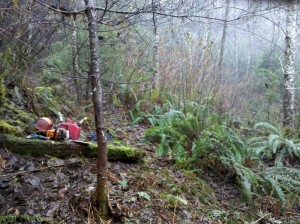 BEFORE: Proposed trail route heading through the South Seep.
BEFORE: Proposed trail route heading through the South Seep.
The little Doug fir in front is suppressed, has a crooked top, and is right in the way, so it will be removed. The extensive brush in the background (mostly salmonberry) obscures the rest of the stand. It is old and is starting to die back due to lack of sunlight in this now closed-canopy alder grove.
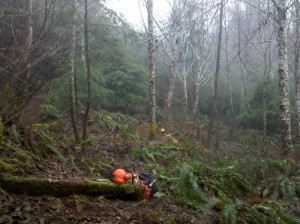 AFTER: Trail opened up through the South Seep.
AFTER: Trail opened up through the South Seep.
Now we can see the individual trees and can walk through the forest easily. There is slash all over the ground on either side of the trail. I just slice up the cull trees, branches and brush to within a few feet of the ground, and let them decompose over time. I only pick them up and toss them if they are on the trail route.
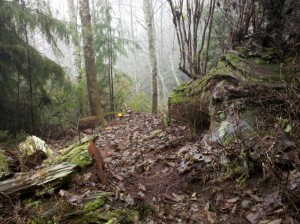 Looking back north along the trail into Alder Seep.
Looking back north along the trail into Alder Seep.
This is a nice raised, dry section between the seeps. Ancient cedar stumps and cut chunks are found wherever you turn in this area. I try to route the trail near the most interesting artifacts of this legacy forest.
Continue Reading | Comments Off on Trail creation through the South Seep
Forestry work in the Alder Seep
FORESTRY: 2.5 hours: 3:00 PM to 5:30 PM
Pre-commercial thinning, pruning and general clean-up in the Alder Seep and Cedar Shake Park in Eastern Wedge unit #5.
Forestry portion of new trail establishment in Eastern Wedge unit #5. Mostly thinning and pruning in the Alder Seep. Completed the section above the trail (top of the seep) up to the eastern property line. The alders have few, widely spaced branches, many of which are dead and pop right off. Most branches are small, as these alders are growing close enough to shade out the understory. A power pole pruner is needed to get the more numerous live branches higher up. Now is the perfect time to create a clean bole for peeler logs – the trees are tall enough (at 16 years old) to allow pruning of all branches that can be reached (up to about 16 feet) – just one lift (pruning) during the life of the tree. Continued pruning alder limbs and felling suppressed and deformed alders, hemlock and Doug fir from the Alder Seep up over the south bank into the next wet zone. Old cedar stumps and remnants of shake bolt cutting are everywhere in this unit.
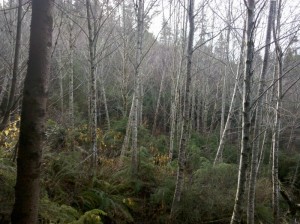 Mostly self-thinned 16 year-old alder in the Alder Seep.
Mostly self-thinned 16 year-old alder in the Alder Seep.
This area was clear-cut sixteen years ago and replanted in Doug fir. Only one Doug fir is visible in the photo (the dark tree trunk on the left hand side), as the naturally regenerated alder quickly captured this wet site and shaded out the fir.
Cut down a few suppressed, bent-over and broken-topped alder, and pruned the low branches. This stand is in surprisingly good shape after surviving the Great Coastal Gale of 2007, and the natural spacing is about right for their age.
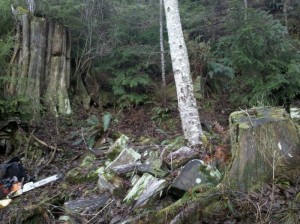 Cedar shake bolts and old cedar stumps in the Alder Seep.
Cedar shake bolts and old cedar stumps in the Alder Seep.
There are old-growth Western Red Cedar stumps and logs all throughout Eastern Wedge unit #5. The forest floor is littered with the rectangular chunks (bolts) cut out of the cedar for shingles or roof shakes. This remnant cedar was highly sought after in recent decades by salvagers looking for the tight, straight grain and rot resistance found only in centuries-old wood.
Now covered in moss and lichen, there’s no telling how long ago these were cut out of the old cedar logs and split into chunks that could be hauled away on foot. Perhaps these chunks were rejects, or the cutters never came back to claim them. In any case, there are hundreds of these strewn over many acres in Eastern Wedge unit #5. Hence the name “Cedar Shake Park”!
Continue Reading | Comments Off on Forestry work in the Alder Seep

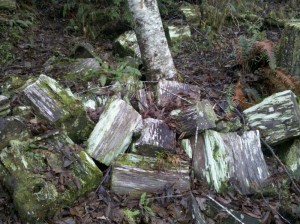
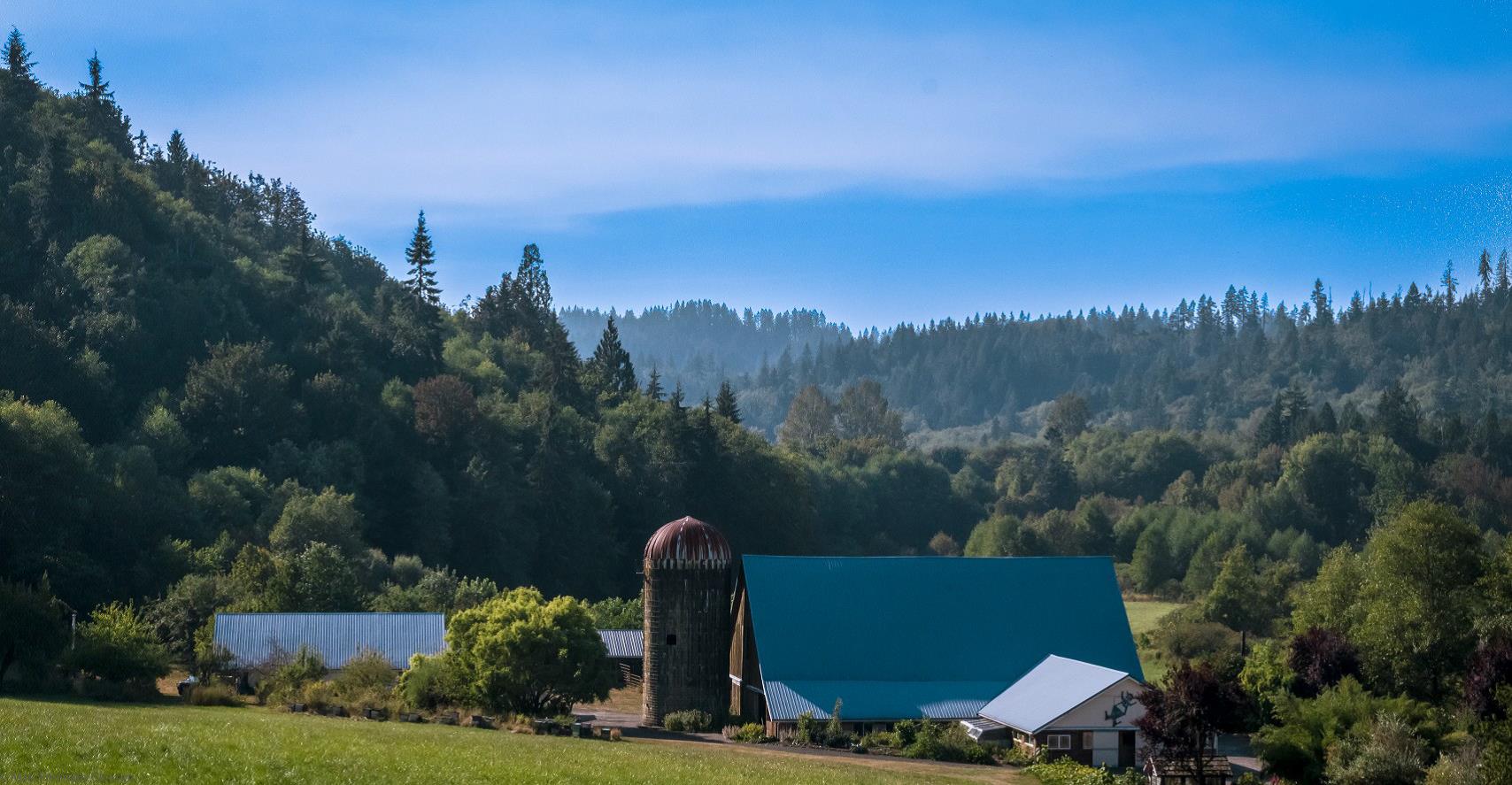


 Spirulina
Spirulina